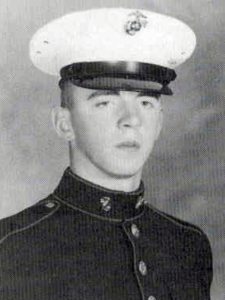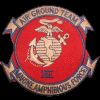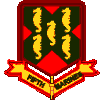After getting his draft notice for the Army, Burt - who was also known as "Rusty"
to his family - ignored his father's earlier advice and joined the Marines, following the same path as many
of his friends. The family learned about his decision one day when he walked into the kitchen with a big
smile. His mother, Jean, asked "What have you done?" He answered by singing the Marine hymn."
In spring of 1968, Miller eagerly shipped out for basic training at Parris Island, S.C. His parents said
he never complained about the physically grueling and emotionally challenging 13-week boot camp. The 6-foot-5-inch,
sandy-haired teenager always had a smile on his face - even during boot camp. His dad recalled: "The drill
instructor told him early on, 'I'll wipe that off your face.' But when he was getting on the bus to leave
Parris Island, the instructor said, 'Burt, give it to me one more time.'"
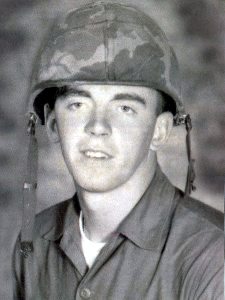
|
Miller grew up in Manchester, Ohio, a suburb of Akron. The oldest of four children, he had an average all-American upbringing
with his brother Blaine, and two sisters, Billie and Darla. Before heading to Vietnam, Miller returned home to northeast Ohio and
enjoyed several weeks with friends and family. If he feared the future, he never told anyone.
In mid-August 1968, Miller joined the battle-hardened and weary 1st Platoon of Lima Company, 3rd Battalion,
5th Marine Regiment, 1st Marine Division. Since spring, the unit had been operating in the An Hoa Valley - a dense jungle
some Marines considered hell on earth because of frequent guerrilla ambushes and numerous booby traps.
The Marines conducted round-the-clock patrols. These operations came at a high cost in lives lost. Miller came under
enemy fire soon after arriving, as the platoon faced an almost constant threat from the enemy where it
operated. On September 12, 1968 fighting was very heavy. It's miraculous that anyone in the platoon
survived that day. About 20 minutes into the fierce fighting, almost totally surrounded, the Americans began running
low on ammunition. With few choices, the platoon called in tactical air support on their own position to avoid
being overrun. Within minutes, four Phantoms roared overhead, dropping a pair of 250-pound bombs and two loads of
napalm. With their noses buried in the trench, many members of the platoon survived. To this day, at company reunions,
the Marines who were holed up in the trench that day are respectfully known as "the survivors." Burt Miller was a survivor,
but not for long. On this day's fighting, the platoon lost PFC Richard Hathaway Arruda.
The difficult jungle conditions took a toll on Miller's health. Constantly wet, cold and sleep deprived, in early October
he was withdrawn from the field with pneumonia. He wrote his mother saying how glad he was to sleep on clean sheets.
After a couple weeks of recuperation, Miller returned to his unit.
In late October Lima Company finally left the An Hoa Valley, but didn't go far. Helicopters dropped the unit above the
valley, on a towering mountain range nicknamed Charlie Ridge. November 4, 1968 - The Marines planned to hike down the
steep 7,000-foot mountain range and begin searching for the enemy near a river that flowed through the valley.
They worked their way down the mountain until they reached a steep incline. They inched their way down the incline
toward a rectangular plateau, which was surrounded on three sides by large boulders, creating a mini-fortress of rock
walls at least six feet high on all four sides. This area, about 20 by 12 feet, offered a place for the men to catch
their breath before continuing their descent of Charlie Ridge.
Three men were passing through to that plateau area by crabwalking down the slope. The Medic named Murphy reached the
plateau first, where he helped the short assistant machine-gunner back to his feet. Stamos was putting his gear in
order as Burt Miller reached the plateau, about ten feet from his two friends. As Miller prepared to stand upright,
Stamos stood with his back to him. Murphy turned toward Miller in time to see a hand grenade flying through the air.
In what seemed like slow motion, the grenade flew through the air and landed on Miller's chest. It rolled down and
caught at his waist where he held the bulky machine gun against his body.
Miller made the decision to not try to grab the grenade and throw it and duck. Instead, he pulled the machine gun as tight as
he could to himself, thus saving the lives of the two men who were with him. Miller was still alive when Murphy reached him but
he died shortly in Murphy's arms.
According to the published article from the Vietnam Magazine (Read full article
with all Photos on the Ohio Veterans'
Memorial Park website at
http://www.ovmp.org/burt_rusty_miller.htm):
"A couple years after Rusty's death, Billie [Miller's sister]
set the table for dinner, almost instinctively putting out six places. Her mother asked, "Why are there six plates?" Billie
thought to herself, because there are six people in this family. Without Burt, however, there were only five. Before Billie
could answer her mother's question, they both realized why she put out six plates and started crying.
Despite the tears, the family held on to their good memories, laughing whenever someone brought up a funny story
involving their son. In later years the grandkids heard so much about Rusty that all 10 felt they knew him. But the
family never completely got over their loss. They just learned to live with the pain. Bob Miller said "There's a hole in
this family that was left when he left, and it will never be filled."
The Navy Corpsman, Murphy, looked up the family and with the Millers' consent, Murphy started a review process in
the fall of 2002 to have Burt Miller considered for a military decoration. But Murphy and the Millers agreed that
medals were not important. "A drawer full of medals...won't bring him back," observed Rusty's father.
Burt Miller is gone forever, but now, 36 years after he died, his family has more peace and comfort. "Now I know why
he had to die," said his sister Darla. "He died saving other people."
However, spurred by an impromptu $100 donation, Gary Kindig of New Franklin, south of Akron, who had served with the
101st Airborne and returned home about two weeks before the death of Miller - one of his best friends from their Manchester
High School days - worked to get a bench dedicated at Ohio Veterans Memorial Park to Burt "Rusty" Miller, the Marine who
died in the war 43 years ago. The Bench was dedicated November 4, 2011. Photos below with bulk of
photos of ceremonies on Ohio Veterans' Memorial
Park website at
http://www.ovmp.org/burt_rusty_miller.htm)
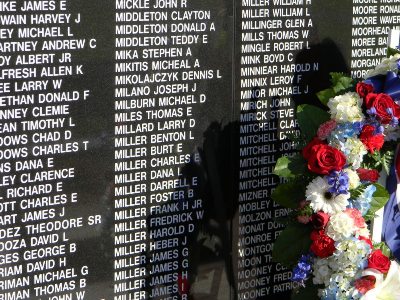
|
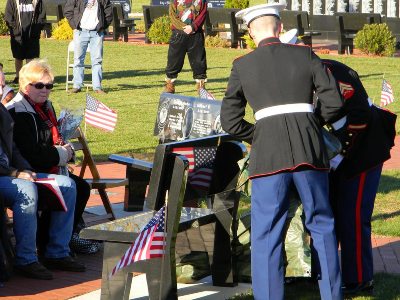
|
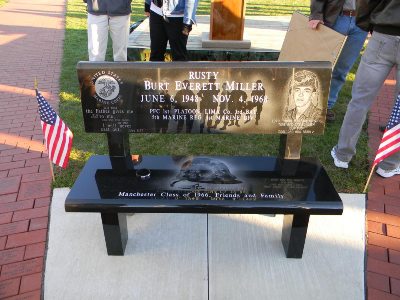
|
-- The Virtual Wall

